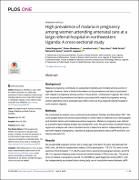| dc.contributor.author | Mangusho, Caleb | |
| dc.contributor.author | Mwebesa, Edson | |
| dc.contributor.author | Izudi, Jonathan | |
| dc.contributor.author | Aleni, Mary | |
| dc.contributor.author | Dricile, Ratib | |
| dc.contributor.author | Mangwi, Richard Ayiasi | |
| dc.contributor.author | Legason, Ismail Draguma | |
| dc.date.accessioned | 2023-04-06T09:22:19Z | |
| dc.date.available | 2023-04-06T09:22:19Z | |
| dc.date.issued | 2023-04-05 | |
| dc.identifier.citation | Mangusho, C., Mwebesa, E., Izudi, J., Aleni, M., Dricile, R., Ayiasi, R. M., & Legason, I. D. (2023). High prevalence of malaria in pregnancy among women attending antenatal care at a large referral hospital in northwestern Uganda: A cross-sectional study. PLOS ONE, 18(4), e0283755. https://doi.org/10.1371/journal.pone.0283755 | en_US |
| dc.identifier.uri | http://dir.muni.ac.ug/xmlui/handle/20.500.12260/538 | |
| dc.description.abstract | Background
Malaria in pregnancy contributes to substantial morbidity and mortality among women in Uganda. However, there is limited information on the prevalence and factors associated with malaria in pregnancy among women in Arua district, northwestern Uganda. We, therefore, assessed the prevalence and factors associated with malaria in pregnancy among women attending routine antenatal care (ANC) clinics at Arua regional referral hospital in north-western Uganda.
Methods
We conducted an analytic cross-sectional study between October and December 2021. We used a paper-based structured questionnaire to collect data on maternal socio-demographic and obstetric factors and malaria preventive measures. Malaria in pregnancy was defined as a positive rapid malarial antigen test during ANC visits. We performed a modified Poisson regression analysis with robust standard errors to determine factors independently associated with malaria in pregnancy, reported as adjusted prevalence ratios (aPR) and 95% confidence intervals (CI).
Results
We studied 238 pregnant women with a mean age of 25.32±5.79 years that attended the ANC clinic, all without symptomatic malaria. Of the participants, 173 (72.7%) were in their second or third trimester, 117 (49.2%) were first or second-time pregnant women, and 212 (89.1%) reported sleeping under insecticide-treated bednets (ITNs) every day. The prevalence of malaria in pregnancy was 26.1% (62/238) by rapid diagnostic testing (RDT), with the independently associated factors being daily use of insecticide-treated bednets (aPR 0.41, 95% CI 0.28, 0.62), first ANC visit after 12 weeks of gestation (aPR1.78, 95% CI 1.05, 3.03), and being in the second or third trimester (aPR 0.45, 95% CI 0.26, 0.76).
Conclusion
The prevalence of malaria in pregnancy among women attending ANC in this setting is high. We recommend the provision of insecticide-treated bednets to all pregnant women and early ANC attendance to enable access to malaria preventive therapy and related interventions. | en_US |
| dc.language.iso | en | en_US |
| dc.publisher | PLOS One | en_US |
| dc.subject | Malaria | en_US |
| dc.subject | Pregnancy | en_US |
| dc.subject | Antenatal Care | en_US |
| dc.subject | Insecticides | en_US |
| dc.subject | Uganda | en_US |
| dc.subject | Malarial parasites | en_US |
| dc.subject | Medical risk factors | en_US |
| dc.subject | Virus testing | en_US |
| dc.title | High prevalence of malaria in pregnancy among women attending antenatal care at a large referral hospital in northwestern Uganda: | en_US |
| dc.title.alternative | A cross-sectional study | en_US |
| dc.type | Article | en_US |

